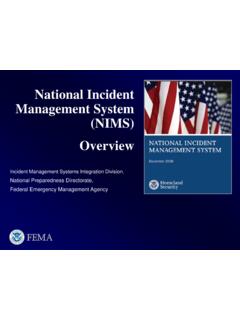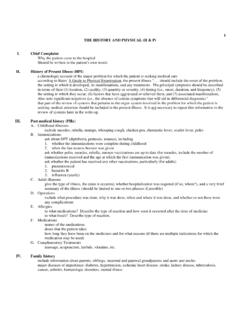Transcription of Primary Care Approach to Eye Conditions and headache.
1 292879810 U8niverUsityeony9iviUfeeWeec0tSs1ehhleeM 0deaeeWeePUuvnbH uitlea,hDOsteopathic Family Physician (2019) 28 - 34 Primary care Approach to Eye ConditionsSharanjit Kaur, DO1; Helaine Larsen, DO1; Alanna Nattis, DO2 1 Good Samaritan Hospital Medical Center, Family Medicine, West Islip, NY2 Lindershurst Eye Physicians and Surgeons, PC, West Islip, NYABSTRACT: Many patients present to the Primary care physician with complaints relating to the eye. While many are benign, others can be vision threatening. Performing a thorough history and physical can quickly assess the severity. More common, often benign Conditions include conjunctivitis, keratoconjunctivitis sicca, blepharitis, subconjunctival hemorrhage, corneal abrasion, stye, chalazion, ectropion, entropion and episcleritis. Other more complex Conditions include ptosis and cataracts.
2 Vision-threatening Conditions including uveitis, malignancies, retinal detachment, acute angle closure glaucoma, globe injuries and chemical burns require immediate recognition and referral to an :Acute Angle-Closure GlaucomaChemical BurnsConjunctivitisRed EyeRetinal DetachmentINTRODUCTIONEye-related complaints make up 2-3% of Primary care office Knowledge of how to respond when these patients present is fundamental for the family physician, as is recognizing when to refer to an ophthalmologist for further care . Family physicians should be able to recognize eye Conditions that can lead to visual loss, therefore requiring urgent referral to the A thorough history and physical is core in making a diagnosis and determining the urgency of the eye condition. History should focus on visual changes, duration of symptoms, presence or absence of a foreign body, history of trauma or recent eye surgery, and associated symptoms, such as a headache, nausea or ocular discharge.
3 Nearly half of the eye problems that present to the family physician include conjunctivitis, keratoconjunctivitis sicca, and corneal More severe Conditions include retinal detachment, acute angle closure glaucoma, mechanical globe injuries and chemical Basic equipment such as a Snellen chart, a tonometer, a penlight, an ophthalmoscope, dilating drops and fluorescein stain are available to the Primary care physician to aid in achieving the correct the AND PHYSICAL EXAMINATIONI nitial evaluation should consist of questions relating to vision loss or change, foreign body sensation, photophobia and headache. If a patient complains of a foreign body sensation then corneal abrasion, retained foreign body or keratitis should be part of the differential diagnosis . A sandy sensation is often associated with keratoconjunctivitis sicca, blepharitis, or dry eye A CORRESPONDENCE: Sharanjit Kaur, DO | 2019 by the American College of Osteopathic Family Physicians.
4 All rights reserved. Print ISSN: 1877-573 Xthorough history of contact lenses use should be obtained focusing on the wearing schedule, overnight use, hygiene protocol, and swimming or showering while wearing a contact lens to rule out a corneal ulcer. If a patient is complaining of photophobia, it could be a sign of corneal involvement. A headache with associated eye pain points toward the diagnoses of acute angle-closure glaucoma, cluster headaches, iritis, and When symptoms recur, a systemic inflammatory disease should be of basic eye anatomy is pivotal for the Primary care physician in order to perform a detailed and complete physical exam. The Primary care physician should inspect the eyelid and sclera for inflammation, abrasions, hemorrhage, erythema or lesions. The upper eyelid should be evaluated and everted if corneal abrasion or retained foreign body is suspected.
5 The eyelid and the periorbital region should be examined for rashes or , Woods Lamp can be utilized to evaluate for corneal abrasion or foreign The conjunctiva should be evaluated for injection, which is indicative of inflammation or All patients complaining of eye pain should be assessed for visual disturbances (Table 1). A Snellen chart should be used to assess visual acuity, having the patient read from a distance of 20 feet. Limitation of ocular motility should be ruled out by performing an exam of extraocular muscle EYE CONDITIONSOne of the most common ophthalmologic diagnoses seen by the Primary care physician is The major causes of conjunctivitis can be divided between noninfectious and (Table 2) Noninfectious causes include allergic, exposure, blepharitis, foreign body, subconjunctival hemorrhage, iritis, chemical burns, REVIEW ARTICLEKaur, Larsen, Nattis Primary care Approach to Eye Conditionsand corneal Other Conditions commonly seen in the Primary care setting include strabismus, uveitis, carcinomas, entropion, ectropion, pterygium, stye, and chalazion (Table 3).
6 EVALUATION AND MANAGEMENT OF COMMON OCULAR CONDITIONSV iral conjunctivitis is most commonly caused by adenovirus and herpes, the former being highly contagious. Viral conjunctivitis is often associated with an upper respiratory infection and other HISTORYP hotophobiaHeadacheDecreased visionContact lens useForeign body sensationTABLE 1:Different causes of eye pain3,6 CAUSESK eratitis, corneal abrasion, acute angle-closure glaucoma, migraineAcute angle-closure glaucoma, migraineOptic neuritis, uveitis, cellulitisCorneal abrasion, keratitis, bacterial conjunctivitis, corneal ulcerCorneal abrasion, dry eye, keratitis, foreign body CONJUNCTIVITIS MOST COMMON CAUSES SIGNS SYMPTOMSTABLE 2:Major causes of conjunctivitis3, 6, 16 ViralHerpes zosterBacterial: acute and chronicBacterial: hyperacuteAllergic (Figure 1)Adenovirus (most common), Herpes Simplex Virus, enterovirus, CoxsackievirusHerpes zosterCommon pathogens (children): Streptococcus pneumonia(adults) Staphylococcus aureusN.
7 GonorrhoeaeAllergensDiffuse conjunctival injections, preauricular lymphadenopathy, lymphoid follicle on the eyelidVesicular rash, uveitis, keratitisEdema, conjunctival injectionsChemosis, possible corneal involvementConjunctival injection, cobblestone papillae under upper eyelidMild to no pain, occasional discomfort with mild itching, watery or serous discharge, often starts of unilateralPain and tingling sensation precedes rash and conjunctivitis, unilateralMild pain, red eye with foreign body sensation, mild purulent discharge, bilateral glued eyes upon awakeningSevere pain, diminished vision, purulent dischargeBilateral involvement, tearing, itching, watery dischargegeneralized systemic symptoms such as a sore throat, fever, and ,5,6 Symptoms of adenoviral conjunctivitis include eye redness, lacrimation, watery discharge and blurred vision.
8 These symptoms are usually mild and often self-limiting after one to two weeks. The treatment is often supportive care with cold compresses and artificial tears. Since viral conjunctivitis is easily transmissible, it is imperative to educate patients regarding strict hand and contact lens hygiene as well as the avoidance of sharing personal objects until their symptoms resolve completely. The Primary care physician should refer the patient 292879810 U8niverUsityeony9iviUfeeWeec0tSs1ehhleeM 0deaeeWeePUuvnbH uitlea,hDOsteopathic Family Physician (2019) 28 - 34 Primary care Approach to Eye ConditionsSharanjit Kaur, DO1; Helaine Larsen, DO1; Alanna Nattis, DO2 1 Good Samaritan Hospital Medical Center, Family Medicine, West Islip, NY2 Lindershurst Eye Physicians and Surgeons, PC, West Islip, NYABSTRACT: Many patients present to the Primary care physician with complaints relating to the eye.
9 While many are benign, others can be vision threatening. Performing a thorough history and physical can quickly assess the severity. More common, often benign Conditions include conjunctivitis, keratoconjunctivitis sicca, blepharitis, subconjunctival hemorrhage, corneal abrasion, stye, chalazion, ectropion, entropion and episcleritis. Other more complex Conditions include ptosis and cataracts. Vision-threatening Conditions including uveitis, malignancies, retinal detachment, acute angle closure glaucoma, globe injuries and chemical burns require immediate recognition and referral to an :Acute Angle-Closure GlaucomaChemical BurnsConjunctivitisRed EyeRetinal DetachmentINTRODUCTIONEye-related complaints make up 2-3% of Primary care office Knowledge of how to respond when these patients present is fundamental for the family physician, as is recognizing when to refer to an ophthalmologist for further care .
10 Family physicians should be able to recognize eye Conditions that can lead to visual loss, therefore requiring urgent referral to the A thorough history and physical is core in making a diagnosis and determining the urgency of the eye condition. History should focus on visual changes, duration of symptoms, presence or absence of a foreign body, history of trauma or recent eye surgery, and associated symptoms, such as a headache, nausea or ocular discharge. Nearly half of the eye problems that present to the family physician include conjunctivitis, keratoconjunctivitis sicca, and corneal More severe Conditions include retinal detachment, acute angle closure glaucoma, mechanical globe injuries and chemical Basic equipment such as a Snellen chart, a tonometer, a penlight, an ophthalmoscope, dilating drops and fluorescein stain are available to the Primary care physician to aid in achieving the correct the AND PHYSICAL EXAMINATIONI nitial evaluation should consist of questions relating to vision loss or change, foreign body sensation, photophobia and headache.




